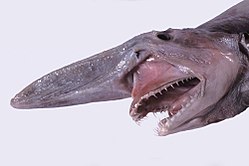Goblin shark - Simple English Wikipedia, the free encyclopedia
| Goblin shark | |
|---|---|
 | |
 | |
| Scientific classification | |
| Kingdom: | |
| Phylum: | |
| Class: | |
| Order: | |
| Family: | |
| Genus: | |
| Species: | M. owstoni |
 | |
| Range of the Goblin shark | |
The goblin shark (Mitsukurina owstoni) is a rare, poorly-known species of deep-sea shark. Sometimes called a "living fossil", it is the only living species in the family Mitsukurinidae.
Males can reach lengths of up to 12.6 feet (3.8 meters), while females can reach up to 12.2 feet (3.7 meters). The heaviest specimen found weighed 210 kg (460 pounds).[2]
Being a bottom-dwelling shark, it inhabits waters as deep as 4,265 feet (1,300 meters) and has been recorded in the Atlantic, Indian, and Pacific Oceans.[3]
Description
[change | change source]The goblin shark can be easily identified by its long, flattened snout. Notable physical features include a noticeably long head, tiny eyes, and five short gill openings. It possesses a large, parabolic mouth, while the body is soft, flabby, and adapted for life in deep waters. The species has a long caudal fin without a ventral lobe. Its pectoral fins are short and wide, and the two dorsal fins are small, rounded, and equal in size. The anal fin is smaller than the dorsals, while the pelvic fins are comparatively larger.
A distinctive feature of the goblin shark is its long, extendable jaw, equipped with long, slender teeth. The overall body shape and soft musculature suggest that it is a slow-moving species of shark.[4]
In terms of coloration, living goblin sharks are pinkish-white with bluish fins. Specimens tend to fade to a brownish hue when preserved in alcohol.
The dentition of the goblin shark includes 26 long, spike-like teeth on the upper jaw and 24 on the lower jaw. Three rows of front teeth are present on each side of both jaws, with a noticeable gap separating the front upper teeth from the smaller upper side teeth.
Mature male goblin sharks have been recorded at lengths ranging from 8.66 to 12.6 feet (2.6 to 3.8 meters). Mature females measure between 11 and 12.2 feet (3.4 to 3.7 meters). The size at birth remains unknown, although the smallest specimen documented measured 3.51 feet (1.07 meters) in length. The heaviest goblin shark on record weighed 210 kg (460 pounds) and measured 3.8 metres (12 feet) long.[5]
Distribution
[change | change source]It is believed that this species of deep-sea shark has a wide distribution. In the Atlantic, specimens have been recorded off the coasts of Guyana, Suriname, French Guiana, France, Madeira, Senegal, Portugal, and within the Gulf of Guinea. In the western Pacific, it has been documented near Japan, Australia, and New Zealand. Reports from the Indian Ocean include sightings off South Africa and Mozambique. More recently, individuals have been recorded in the U.S.A., near San Clemente Island off the coast of California, as well as in the northern Gulf of Mexico south of Pascagoula, Mississippi.[5]
Habitat
[change | change source]Rarely observed at the surface or in shallow coastal waters, this species typically inhabits outer continental shelves, upper slopes, and areas around seamounts. Most specimens have been documented near continental slopes, at depths ranging between 885 and 3,149 feet (270 and 960 meters). It has also been recorded as deep as 4,265 feet (1,300 meters) and as shallow as 311 to 449 feet (95 to 137 meters). Existing records suggest that the goblin shark may also exhibit oceanic behavior.[5]
Feeding
[change | change source]The goblin shark uses electro-sensitive organs to detect its prey. When it identifies a target, its jaws can rapidly project forward, aided by a double set of ligaments at the mandibular (lower jaw) joints. These ligaments stretch when the jaw is withdrawn and relax when the jaw is thrust forward, functioning like a catapult to capture prey. While swimming, the jaws are typically held tightly in place. The shark’s front teeth are specialized for crushing, and it feeds on a variety of prey, including shrimp, pelagic octopuses, fish, squid, and possibly crabs[2] and deep-sea rockfish.[6]
Reproduction
[change | change source]Little is known about the reproductive habits of the goblin shark. To date, no pregnant female has been captured or examined. It is believed to be ovoviviparous, with young born live after developing inside eggs retained within the mother’s body. In this mode of reproduction, there is no placental connection; instead, the embryos are nourished by yolk sacs. Information regarding the species' age at maturity, mating behavior, and gestation period remains unknown.[7]
Human interactions
[change | change source]The goblin shark is commercially fished off Japan and is occasionally caught alongside cutlassfish off Portugal. In other regions, it is primarily taken as bycatch in deep-water trawls, though it is also occasionally captured with deep-water longlines, deep-set gillnets, and sometimes purse seines.[8]
Although the species is likely harmless, its rare encounters with humans make it difficult to fully assess its behavior.[9]
References
[change | change source]- ↑ Duffy, C.A.J.; Ebert, D.A.; Stenberg, C. (2004). "Mitsukurina owstoni". IUCN Red List of Threatened Species. 2004: e.T44565A10907385. doi:10.2305/IUCN.UK.2004.RLTS.T44565A10907385.en.
- ↑ 2.0 2.1 "FLMNH Ichthyology Department: Goblin Shark". Florida Museum of Natural History. 2016-02-01. Archived from the original on 1 February 2016. Retrieved 11 May 2025.
- ↑ "CREATURE FEATURE: GOBLIN SHARK". The Shark Trust. 2023-04-03. Retrieved 2025-05-11.
- ↑ "The Protrusible Jaws of the Goblin Shark". SHARK ANGELS. Retrieved 2025-05-11.
- ↑ 5.0 5.1 5.2 "FLMNH Ichthyology Department:Goblin shark". flmnh.ufl.edu. Archived from the original on 1 February 2016. Retrieved 10 July 2013.
- ↑ BioExpedition (2012-06-13). "Goblin Shark". BioExpedition. Retrieved 2025-05-11.
- ↑ "Goblin Shark-Animal Facts and Information". bioexpedition.com. 13 June 2012. Retrieved 10 July 2013.
- ↑ "CREATURE FEATURE: GOBLIN SHARK". The Shark Trust. 2023-04-03. Retrieved 2025-05-11.
- ↑ "Goblin Sharks, Mitsukurina owstoni~MarineBio.org". marinebio.org. Retrieved 10 July 2013.


 French
French Deutsch
Deutsch